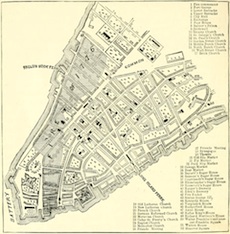The Skyscraper Museum is devoted to the study of high-rise building, past, present, and future. The Museum explores tall buildings as objects of design, products of technology, sites of construction, investments in real estate, and places of work and residence. This site will look better in a browser that supports web standards, but it is accessible to any browser or Internet device.
FIRE OF 1776

Martha J. Lamb, History of the City of New York: its origin, rise and progress, Volume 2, 1877, pg. 136. Retrieved from www.archive.org
New York was the only American city to remain under British military occupation for nearly the entire Revolutionary War, and it suffered more physical damage than any other city. In late 1776, the American troops under General Washington fought a series of battles in Brooklyn and Manhattan, and by the end of summer, they were dispirited and in danger of being surrounded. On September 12, Washington accepted the advice of his officers to abandon the city. The British occupied Manhattan for the remainder of the war, holding patriot prisoners of war in appalling conditions in the Bayard Sugar House on Wall Street.
Just after midnight on September 21, a fire broke out in the Fighting Cocks Tavern on Whitehall Street and quickly spread uptown and by 2 a.m. had consumed Trinity Church. By the time the fire burned out around midmorning, more than 500 houses, one quarter of the city's total, were destroyed. The British were quick to suspect arson and rounded up about two hundred men and women for questioning, including a young captain named Nathan Hale, who admitted to being an American spy and was hanged the next morning. The housing shortage produced by the fire, and another in 1778, caused a number of churches, including the First Presbyterian Church on Wall Street, to be commandeered for barracks, prisons, or storehouses. Large shantytowns filled the burned-out areas, and rebuilding did not begin in earnest until after the war ended.
